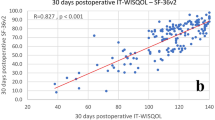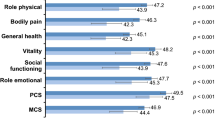Abstract
The Spanish version of the Wisconsin Stone Quality of Life (WISQOL) questionnaire was developed and validated. A double-back translation of the WISQOL was conducted and syntactic amendments were made, resulting in the Spanish version of the WISQOL (S-WISQOL) which then went through a readability analysis. Stone formers from two hospitals in Mexico (Merida and Monterrey) filled in the S-WISQOL and the Short Form 36 (SF36). Convergent validity was assessed by the correlation of both questionnaires. Internal consistency was evaluated by Cronbach’s α, and external validity by comparing between centers. The impact of clinical settings on patients’ health-related quality of life (HRQOL) scores was tested. Each hospital’s institutional review board approved the project and informed consent was obtained from all participants. A total of 87 Spanish-speakers patients completed the S-WISQOL and SF36 and a good correlation was found between both (r = 0.75, p < 0.001). S-WISQOL readability was rated as “easy”. Patients from Merida had longer median duration (years) with stones, more stone-related procedures, and hospitalizations, and scored lower on WISQOL (p = 0.006). Internal consistency was good as Cronbach’s α coefficients ranged between acceptable and excellent. Stone-related admissions and duration of stones were inversely correlated with S-WISQOL score (− 0.254 and − 0.283, respectively; p < 0.005) but not to SF36. The S-WISQOL is an internally consistent, reliable, and valid instrument to assess HRQOL in Spanish-speaking patients with kidney stones. The S-WISQOL is generalizable as demonstrated by good external validity among centers. S-WISQOL scores can be added as an outcome for kidney stone treatments.

Similar content being viewed by others
References
Sorokin I, Mamoulakis C, Miyazawa K, Rodgers A, Talati J, Lotan Y (2017) Epidemiology of stone disease across the world. World J Urol 35(9):1301–1320. https://doi.org/10.1007/s00345-017-2008-6
Alatab S, Pourmand G, El Howairis MEF, Buchholz N, Najafi I, Pourmand MR et al (2016) National profiles of urinary calculi: A comparison between developing and developed worlds. Iran J Kidney Dis 10(2):51–61
Saigal CS, Joyce G, Timilsina AR, Urologic Disease in America Project (2005) Direct and indirect costs of nephrolithiasis in an employed population: opportunity for disease management? Kidney Int 68(4):1808–1814. https://doi.org/10.1111/j.1523-1755.2005.00599.x
Medina-Escobedo M, Zaidi M, Real-de-León E, Orozco-Rivadeneyra S (2002) Prevalencia y factores de riesgo en Yucatán, México, para litiasis urinaria. Salud Pública Mex 44(6):541–545
Medina-Escobedo M, Martín-Soberanis G (2009) Nefrolitiasis como indicación de nefrectomía. Estudio multicéntrico. Rev Med Inst Mex Seguro Soc 74(1):29–32
Bryant M, Angell J, Tu H, Goodman M, Pattaras J, Ogan K (2012) Health related quality of life for stone formers. J Urol 188(2):436–440. https://doi.org/10.1016/j.juro.2012.04.015
Romero V, Akpinar H, Assimos DG (2010) Kidney stones: a global picture of prevalence, incidence, and associated risk factors. Rev Urol 12(2–3):86–96
New F, Somani BK (2016) A Complete world literature review of quality of life (QOL) in patients with kidney stone disease (KSD). Curr Urol Rep 17(12):88. https://doi.org/10.1007/s11934-016-0647-6
Vilagut G, Ferrer M, Rajmil L, Rebollo P, Permanyer-Miralda G, Quintana JM et al (2005) The Spanish version of the Short Form 36 Health Survey: a decade of experience and new developments. Gac Sanit 19(2):135–150. https://doi.org/10.1157/13074369
Penniston KL, Nakada SY (2013) Development of an instrument to assess the health-related quality of life of kidney stone formers. J Urol 189(3):921–930. https://doi.org/10.1016/j.juro.2012.08.247
Penniston KL, Antonelli JA, Viprakasit DP, Averch TD, Sivalingam S, Sur RL et al (2017) Validation and reliability of the wisconsin stone quality of life questionnaire. J Urol 197(5):1280–1288. https://doi.org/10.1016/j.juro.2016.11.097
Fernández-Huerta J (1959) Medidas sencillas de lecturabilidad. Consigna (214):29–32 https://legible.es/blog/lecturabilidad-fernandez-huerta/#id1. Accessed 6 Mar 2018
Atalay HA, Ulker V, Canat L, Ozer M, Can O, Penniston KL (2018) Validation of the Turkish version of the Wisconsin stone-quality of life questionnaire. Turkish J Urol 16:1–6. https://doi.org/10.5152/tud.2018.35305
Penniston KL, Sninsky BC, Nakada SY (2016) Preliminary Evidence of Decreased Disease-Specific Health-Related Quality of Life in Asymptomatic Stone Patients. J Endourol 30(Suppl 1(S1)):S42–45. https://doi.org/10.1089/end.2016.0074
Donnally CJ, Gupta A, Bensalah K, Tuncel A, Raman J, Pearle MS et al (2011) Longitudinal evaluation of the SF-36 quality of life questionnaire in patients with kidney stones. Urol Res 39(2):141–146. https://doi.org/10.1007/s00240-010-0313-2
Pérez-Fentes DA, Gude F, Blanco B, Freire CG (2015) Percutaneous nephrolithotomy: short- and long-term effects on health-related quality of life. J Endourol 29(1):13–17. https://doi.org/10.1089/end.2014.0081
Eryildirim B, Sahin C, Tuncer M, Sabuncu K, Cetinel C, Tarhan F et al (2015) Effect of medical expulsive therapy on the health-related quality of life of patients with ureteral stones: a critical evaluation. Int Urol Nephrol 47(8):1271–1275. https://doi.org/10.1007/s11255-015-1036-7
Jiang H, Huang D, Yao S, Liu S (2017) Improving drainage after percutaneous nephrolithotomy based on health-related quality of life: a prospective randomized study. J Endourol 31(11):1131–1138. https://doi.org/10.1089/end.2017.0444
de Sousa MN, Pereira JP, Mota P, Carvalho-Dias E, Torres NJ, Lima E (2018) Percutaneous nephrostomy vs ureteral stent for hydronephrosis secondary to ureteric calculi: impact on spontaneous stone passage and health-related quality of life—a prospective study. Urolithiasis 47:567–573. https://doi.org/10.1007/s00240-018-1078-2
Raffin EP, Penniston KL, Antonelli JA, Viprakasit DP, Averch TD, Bird VG et al (2018) The effect of thiazide and potassium citrate use on the health-related quality of life of patients with urolithiasis. J Urol 200(6):1290–1294. https://doi.org/10.1016/j.juro.2018.06.023
Modersitzki F, Goldfarb DS, Goldstein RL, Sur RL, Penniston KL (2019) Assessment of health-related quality of life in patients with cystinuria on tiopronin therapy. Urolithiasis. https://doi.org/10.1007/s00240-019-01174-6
Acknowledgements
No competing financial interests exist. Partial results of this paper were presented in the 36th World Congress of Endourology in Paris in 2018.
Author information
Authors and Affiliations
Contributions
MB-M: protocol/project development, data collection or management, data analysis and manuscript writing/editing. JPF-T: protocol/project development and data collection or management. MDG-P: protocol/project development and data collection or management. AH: protocol/project development and data analysis. CM-P: protocol/project development, and data analysis. DO-P: protocol/project development, data collection or management, data analysis and manuscript writing/editing. KP: protocol/project development, data analysis and manuscript writing/editing. IAV-M: protocol/project development and data collection or management.
Corresponding author
Ethics declarations
Conflicts of interest
All authors declare that they have no conflict of interest.
Ethical approval
All procedures performed in studies involving human participants were in accordance with the ethical standards of the Institutional Research and Ethics Committee (Reference Number: 2017–012) of the HRAEPY and with the 1964 Helsinki Declaration and its later amendments or comparable ethical standards. Informed consent was obtained from all individual participants included in the study.
Additional information
Publisher's Note
Springer Nature remains neutral with regard to jurisdictional claims in published maps and institutional affiliations.
Rights and permissions
About this article
Cite this article
Basulto-Martínez, M., Olvera-Posada, D., Velueta-Martínez, I.A. et al. Quality of life in patients with kidney stones: translation and validation of the Spanish Wisconsin Stone Quality of Life Questionnaire. Urolithiasis 48, 419–424 (2020). https://doi.org/10.1007/s00240-020-01192-9
Received:
Accepted:
Published:
Issue Date:
DOI: https://doi.org/10.1007/s00240-020-01192-9




